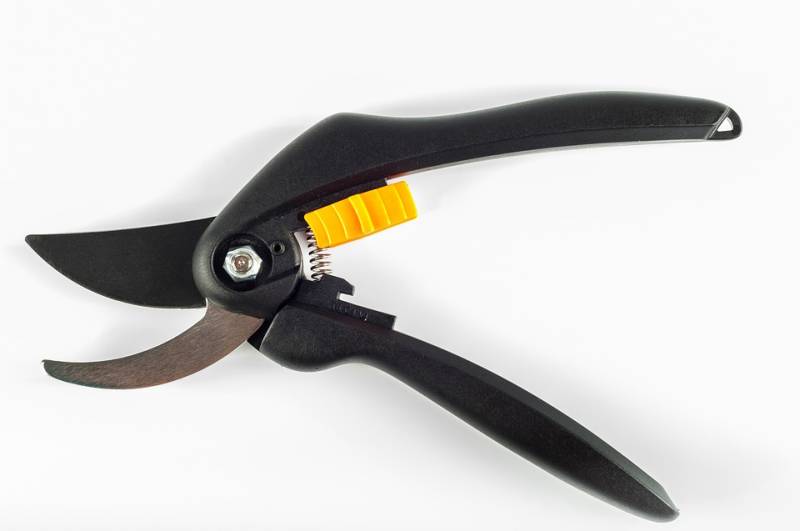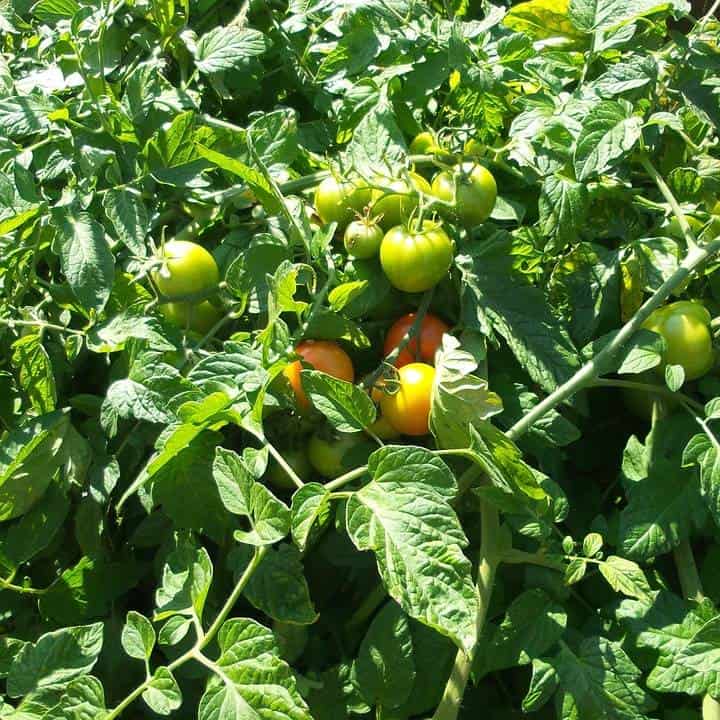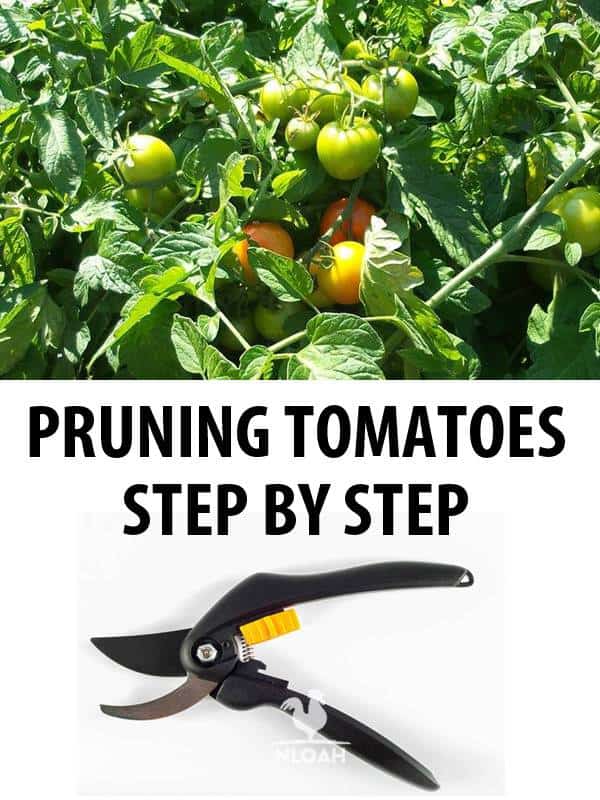Tomatoes are one of the most commonly grown vegetables around the globe, often receiving the affectionate nickname of “kingpin of the garden.”
While it is really easy to grow tomatoes in a garden, doing it correctly and successfully is another story. Proper care is very important to avoid compromising your crop. Regular maintenance activities, such as pruning, are incredibly important.
Pruning is the process of cutting back and getting rid of excess or dead parts of plants to keep them healthy and to increase yield.
Here’s how to prune tomatoes the right way. First, consider the following items.
The Tomato Variety You’re Growing
Know the variety of your tomato plant. It may be a determinate variety or an indeterminate variety of tomato. Only prune tomato plants if they are of an indeterminate variety. This is because indeterminate plants can grow flowers, (i.e. new tomatoes), throughout the season, while determinate plants cannot.
Determinate and indeterminate varieties have different growing habits. While determinate varieties can only grow to a specific size (4 to 5 feet tall) and ripen their fruits quickly (in about 2 weeks), indeterminate ones typically grow to larger sizes. Once determinate plants start producing tomatoes, they won’t repeat the process again, so no tomatoes will be grown after a first harvest.
These are also called bush tomatoes since their growth is halted partway through the growing season. Therefore, pruning this kind of tomato plant isn’t needed, as they stop growing on their own. Some determinate varieties are Ace 55, Biltmore, Mountain Pride, and Patio tomatoes.
On the other hand, indeterminate tomato varieties behave in the opposite manner. They have a tendency to produce additional fruit and flowers, for harvest after harvest. This is why these plants need pruning. Common indeterminate varieties of tomatoes are Black Prince, Beefmaster, and German Queen.
Gather the Right Tools
Pruning plants looks easy but it requires a good amount of knowledge and equipment. You need to have the right tools available to carry out a smooth and safe pruning job.
Keep in mind that all pruning tools to be used should be cleaned and sharp so that any risks are minimized.
One of the most common risks in pruning tomatoes is the spreading of infections. One wrong cut, and you can end up damaging the plant. To err on the safe side, use alcohol to clean the tools before using them on the plant.

You can carry out a smooth pruning job with the help of these three tools: loppers, shears, and hand pruners. If your tomato plant is too large for these tools, use a saw to cut down dead or infected branches.
Start from the Bottom
Always start the pruning process from the bottom, and not the top. This will help you track your progress on how much pruning you have done.
If you prune a large tomato plant from the top, the leaves might hide some suckers or branches that need to be removed, making it difficult to properly complete the job. Instead, start from the bottom and cut off branches one by one.
Another benefit to starting from the bottom is that it provides you with the ability to keep a safe distance away from the stem, which you definitely do not want to damage. If you prune from the top, it might be more difficult to find the stem because branches and leaves will most likely cover it. It’s also easier to search for stems that are growing separately. They need to be cut because these stems can suck all the nutrients of the plant.
Removing Unwanted Leaves and Stems
When you start pruning from the bottom, look for leaves and stems that look unsightly, damaged or diseased.
Start pinching them off from the base by holding them in-between your index finger and thumb. Exert minimal force so that only the stem and leaf you want to remove will actually be removed. Keep in mind that pinching can only ease your difficulties if the plant is smaller and that it won’t help with larger plants.
If you’re dealing with a large plant, use a prune shear to cut off the damaged leaf or stem. This should be done carefully so that no wound is inflicted on the plant. If you accidentally cut the plant, dress the wound quickly to prevent decay.
If the leaves and stems are small and difficult to pinch with hands, use a small, razor- sharp blade to cut them off.
More on removing leaves:
Don’t Remove Too Many Leaves and Stems
Gardeners often make the mistake of removing and cutting a lot of leaves and stems from a tomato plant in one fell swoop. This move can cause long-term problems in the plant, preventing it from functioning properly.
Removing many leaves from a plant causes reduced potential for photosynthesis and functioning. This will hinder its growth because nutrient content will lower significantly and the plant may eventually die.
Stems are essential to the plant as well, so leave several intact so they can produce more tomatoes. A healthy, average tomato plant should have at least four or five tomato producing stems.
If the plant is exposed to direct sunlight, don’t cut too many leaves and stems that provide shade, as too much sunlight can also be damaging. Most importantly, while pruning, make sure that you never prune more than a third of the entire plant at a time.
Suckers
In indeterminate plants, tiny branches begin to sprout from those that meet the stems. Suckers should be pruned as soon as you see them. Here is why.
Tomato plants are like a solar-powered sugar factory. During their first month of growth, the sugar they produce is consumed entirely by the leaves in order to grow.
When suckers begin to develop, they also start growing flowers and fruit, which affects the balance of the plant. This is because very minimal sugar reaches the suckers and fruits don’t get the juice they need. As a result, the quality of the fruit is lower than that of healthier stems.
As a result, it is essential to prune suckers. Since they don’t initially receive the sugar they want from the plant, they tend to suck it away from other areas of the plants, ruining the entire growth process.
Suckers in tomato plants can be dealt in one of two ways.
Simple Pruning
The first way to prune a sucker off is to simply pluck it off while it’s still small and succulent. This is known as simple pruning and is done in the initial stages when a tomato plant is freshly planted.
Grab the base of the sucker from your index finger and your thumb and gently move it back and forth to weaken its foundation. This will break it off and inflict a tiny wound which will heal very quickly.
Note that, a knife or any sharp object shouldn’t be used if the sucker is small because it may infect the place where you cut it off. However, sometimes, particularly due to weather conditions, even smaller suckers can become stiff and hard to snap off. In this case, you can use a small blade to remove the sucker.
Missouri Pruning
Another way to get rid of suckers involves pinching off just the tip of the sucker, leaving two or more leaves intact. This is known as Missouri pruning.
Doing this can be beneficial for a tomato plant because the plant has more leafy area and can aid in photosynthesis, as well as in protecting the plant from sun scald. However, the drawback to this is that it allows more suckers to develop, increasing your pruning chores.
Missouri pruning should be done for very large suckers. When a plant is left idle for long, it provides enough time for suckers to grow, since they feed on the sugar present in the plant. Therefore, suckers get large and Missouri pruning serves as the most suitable type of pruning in this case.
When you just cut the tip of a large sucker, the plant’s stem is at a good distance and won’t be developing any infection as a result of a cut. Cutting just the tip will save the plant from getting a shock because to a large plant, it’s just a small cut.
Suckers tend to grow more quickly in the summer. This is when tomato plants need the most attention. If you don’t do anything to them, the suckers will grow in every direction they can and tangle themselves, making them harder to prune.
Pruning the Right Way
There’s no doubt that pruning can increase your yield in a number of ways, but you can take this up a notch by selecting suitable conditions to conduct pruning.
There are two main conditions that you should consider when scheduling your pruning. These are:
- The time of day
- The condition of the plant
The best time to prune is in the morning, because that’s when light conditions are good and you can prune smaller suckers or branches with ease. Pruning at night is more dangerous, because with the low light it will be easier for you to inflict injuries to the plant, or even kill it.
It’s also a good idea to prune your plant while it’s dry, so never prune your plant after you’ve watered it. If you prune while the plant is wet, it can easily get a cut and the infection may spread rapidly, as the plant is damp and will welcome infection more easily.
- A tomato plant is definitely ready to be pruned if it begins to turn yellow.
- If you see any flower clusters growing below the plant that are 12 to 18 inches tall, then grab a pruning shear and cut them off.
- If you think pruning your plant means you don’t have to do it again for months, think again. This is a repetitive process that needs to be carried out on a weekly basis.
Tomato plants develop rapidly and will grow many unwanted stems, branches and leaves, seemingly overnight.
When you prune your plants once every week, it will keep your plant healthy, safe, and productive. It will also eliminate the future hassle you might face if pruning is not done on a regular basis.
Keep in mind that if your plant is suffering from any disease, you should refrain from pruning until it is completely healed or the infection might spread.
Parts You Should Prune
If the tomato plant in your garden is freshly planted, then you need to delay the pruning process and give it some time to grow more stems and flowers.
When the stem grows above five inches and you see that the plant is developing or supporting dead-looking, broken or injured branches, cut them off with a hand pruner.
Sometimes, two branches are so close to each other that they rub against or cross each other. Cut them as well. However, remember that new branches and stems will grow into the place you just pruned, so make sure you cut them with caution to avoid inflicting more injury. .
Moreover, branches or limbs that hang close to the ground or are too saggy should also be removed. These pieces are an open invitation for insects and other organisms that can pose a threat to the plant. Prune them with a hand pruner if they’re small or use a saw if they’re thicker.

Pruning Laden Branches of Large Tomato Trees
The most crucial part of a large tomato tree is its top most part that contains laden, heavily weighted branches. Harvest as many ripe fruits as you can before beginning, and then follow this advice.
Expert gardeners recommend cutting off the top part of the tomato plant if the plant has grown extremely large. This is also called topping the plant, and it is responsible for stopping the upward growth of the plant.
However, opinions on this are divided. Many gardeners think that cutting the top part of the plant can damage it. Nonetheless, most experts ultimately agree that it is a good idea to cut off the top part as it can prevent potential problems.
If you have the conditions to let the top part grow, then you can let it grow. But, here are some of the benefits of getting rid of the top part:
- Increased Production: It isn’t a good idea to let the top branches grow indefinitely. This will affect the yield because the fruit-bearing branches may get heavy and sink. Therefore, make sure you cut off the extra bushes and branches that begin to grow extensively.
- Fewer Diseases: It is not easy to keep your plants safe from diseases. Pruning large tomato plants, especially the top vines that begin to get out of hand, can help you keep many diseases at bay. This is because when you prune the top part of the tomato plant, you make room for both sunlight and improved air circulation. Thus, the plant stays healthy and more resistant to disease.
How to Top Tomatoes
We know that large tomato plans should be grown inside a large cage when they reach height of more than a few feet. If you don’t like the cage idea, you can also stake or tie up plants that are under six feet in height. In some cases, you can also top you plants to maintain appropriate height and support.
Topping tomato trees requires a good eye, precision and consistency. First, you need to identify the top area where you think you need to work. If you see that some stems are growing upward and growing laden branches (getting low due to heavy weight), vertically cut each stem.
Use pruning shears to cut the stems, but do so above the place where fruits are sprouting from branches. Leave the fruit branches as they are.
Cut the stem about ¼ inch above from the place where smaller side stems are coming out. This will reduce the load on the stem and also restrict its upward growth.
While topping the top branches and stems, try to leave a small amount of shade coming from neighboring branches and covering the tomatoes. The shade will protect the tomatoes from sun scald (a condition which can damage tomatoes due to direct sun exposure).
Make a habit of topping your tomato plants on a weekly basis. Every time you cut the top stem or branch, the energy is diverted to the lateral stems and the upward growth is slowed down, giving your tomatoes more room to grow and develop.
Topping tomatoes is good for tomato plants when they have grown too large. If they are left to grow at their will, it may weaken the stems and cause you problems.
More on topping tomatoes:
The Verdict
Pruning has many other benefits not listed in this article, chiefly in that pruning tomato plants can increase your overall yield and success. This practice helps increase the production as the damaged parts are removed and new tomatoes grow in place. Always prune carefully, and do it during the day so you don’t damage the plant.
Pruning plays a vital role in keeping tomato plants healthy and safe. While it may seem complicated, you won’t find it difficult or tedious once you get in the habit of pruning on a regular basis.

Michael is in love with nature and loves to spend his weekends with his pet dog at his farm where he grows organic fruits and vegetables. He’s a single parent who loves the idea of simple living.

This is a very helpful article! I’ve tried pruning in a few different ways and even tried not pruning at all just as an experiment. I’ve definitely found that proper pruning both increases production and reduces disease and even insect pressure. Lots of great tips here. Thanks.